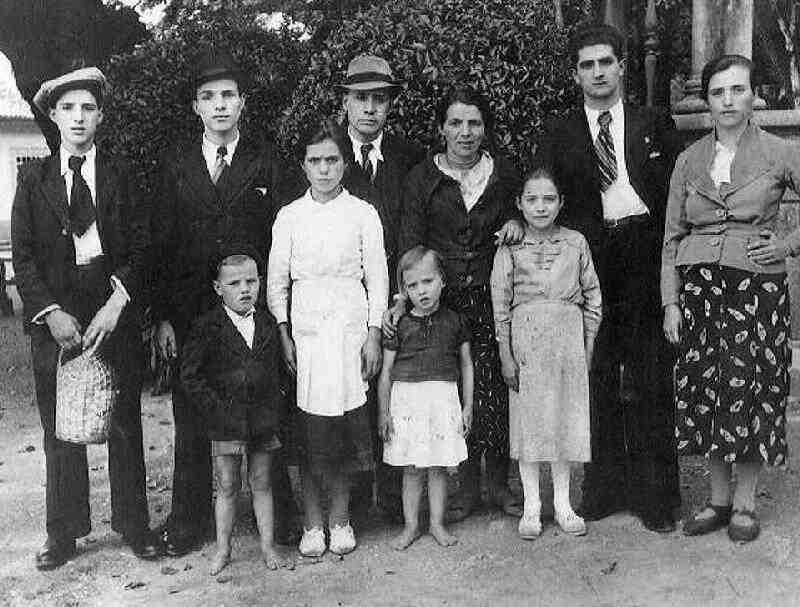
Portuguese Boys' Clothes: Families

Figure 1.--This photo shows a Portuguese family in Santo Estêvão das Galés, a village about 25 km north of Lisbon. The photo is undated but was probably taken about 1950. The family seems dressed up for some occasion. Note that the two younger children are barefoot. To go barefoot was very common for Portuguese children till 1980s.
|
|
A very useful section on HBC is the family section. Here we can see how all the members of the family dressed. This provides insights on the clothing associated with various styles of boys clothes over time. The family images also provide useful sociological insights concerning family size, demographics, social class , and other factor. Here we include both formal portraits and snapshots all of which offer interesting insights.
This is a studio portrait of a family from Nazaré, a port town. Given the way they are dressed, they must hasve been a fishermen family. We can assume that they are wearing their best clothing, which don't include any footwear. The portrait is undated. Since they are wearing traditionasl clothing, it is difficult to date the portrait. Traditional styles do not change like modern styles. We would guess it was taken in the late-19th century.
This photograph shows the Ruah children with their toys. The Ruah were a wealthy Jewish family that settled in Portugal from Morocco (19th century). This was possible after the Portuguese Government finally suppressed the Inquisition (1821). At the right, another child unassociated withthe Ruah children, is looking at the scene. We don't know who he was. He looks like a street child. We don't know even why he is in the photo. It provides a comparison between wealthy and poor children. The photo was taken in Lisbon during the early-20th century. Readers have asked about the image. So we thought it might be useful to assess the image and family in more detail. We had never heard of the Ruah family, but younger Americans are familar with the name. Daniela Sofia Korn Ruah is a popular Portuguese-American actress.
Here we have a large Portuhuese family we think in the early-020s. The OPiortuguese source thouought it was the 1910s. There are 11 children. The older children are mostly girls. The younger children are mostly boys. The girls who look to be about 10-20 years old wear white dresses and hair bows. One of the dresses ooks like a sailor dress. Another seems more like a smock. The boys who look to be about 2-9 years old mostly wear smocks. We are unsure about the color. The fact that all the children have footwear suggests that this was a reasonably well off family. We are not ure where the photograph was tsken but it does not look like a backyard. This is a postcard back snapshot. It was developed in Oporto.
Unidentified Village Family (about 1950)
This photo shows a Portuguese family in Santo Estêvão das Galés, a village about 25 km north of Lisbon. The photo is undated but was probably taken about 1950. The family seems dressed up for some occasion. Note that the two younger children are barefoot. To go barefoot was very common for Portuguese children till 1980s. Portugal sat the time was one of the poorest countries in Europe.
Many Portuguese children commonly went barefoot all the summer until the 1970s and even the early-80s. A reader tellsus that he first saw that in 1979 in the villages near Porto. The photo here was taken in Nazaré, Portugal. These people are wearing the characteristic checkered clothing of the fishermen from Nazaré. Tis is today Portugal's most famous fishing village, drawn visitors to its beautiful beach and colorful life. The photo here is undated. The colored image suggess it was probably taken in the 1950s. It is a timeless scene that could come from the 19th century as well from 1970s. These garments were worn as usual clothing in everyday life. Traditionally no footwear was worn by Nazaré fishermen, both
children and adults.
This photo was taken in 1967 in Praia de Mira, a Portuguese costal village about 250 km north of Lisbon. The family has taken his photo with their car. At the time only some Portuguese families could buy a car. There are three brothers. Two of them are married. In the photo we can see their wives and their children. One of the women is wearing mourning attire. As usual at the time, all the children are barefoot.
HBC

Navigate the Boys' Historical Clothing Web Site:
[Return to the Main postcard country page]
[Introduction]
[Biographies]
[Chronology]
[Clothing styles]
[Country]
[Photography]
[Bibliographies]
[Contributions]
[FAQs]
[Glossaries]
[Images]
[Links]
[Registration]
[Tools]
[Boys' Clothing Home]
Navigate the Boys' Historical Clothing Portuguese pages:
[Portuguese choirs]
[Portuguese movies]
[Portuguese orphanages]
[Portuguese school uniforms]
[Portuguese sailor suits]
[Portuguese youth groups]
Navigate the Boys' Historical Clothing Web Site:
[Return to the Main Portuguese page]
[Return to the Main country page]
[Australia]
[Canada]
[England]
[France]
[Germany]
[Ireland]
[Italy]
[New Zealand]
[Poland]
[Scotland]
[United States]
Created: 2:54 AM 4/7/2009
Last updated: 11:36 PM 12/24/2018



